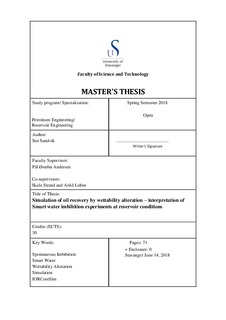| dc.description.abstract | More than 50 % of the proven oil resources in the world are present in carbonates, but the recovery rate is relatively low. Accordingly, a lot of focus has been on improving the efficiency of carbonate reservoirs by applying enhanced oil recovery (EOR) methods. Since most of the fractured carbonate reservoirs are oil-wet, the reservoir rock will hold more strongly onto the oil compared to a water-wet rock. Spontaneous imbibition (SI) of Smart water is the main recovery mechanism in carbonate reservoirs, where a wettability alteration towards a more water-wet rock takes place. When Smart water spontaneously imbibes into a chalk core, SO42- will adsorb onto the positive water-wet surface sites, whereas Ca2+ complexes with carboxylates in the oil. Subsequently, some of the organic materials are released from the surface and contributes to a higher oil recovery.
Several analytical and numerical models have been developed to describe the SI process in carbonate reservoirs. The models aim to capture the complex interactions between the imbibing Smart water, crude oil, formation water and the rock surface. In this study, a 3-D simulation model is built, where the wettability alteration of chalk is linked to the amount of sulfate adsorption in an anion exchange process. By using the simulation software IORCoreSim, the dynamical shift from a neutral wetting system towards a more water-wet system is illustrated, and the simulated oil recoveries are matched towards laboratory experiments executed by Puntervold et al. (2015).
The results showed that the anion exchange model can capture a wettability alteration due to sulfate adsorption in carbonate reservoirs. The model can predict the main oil recovery trends of the laboratory experiments (Puntervold et al., 2015), but is sensitive to important parameters as the temperature of the system and the concentration of Ca2+. It has been concluded that the anion exchange model is not adequate to thoroughly capture the complexity of these systems, however, the model can be used as a basis for further investigations. | nb_NO |
